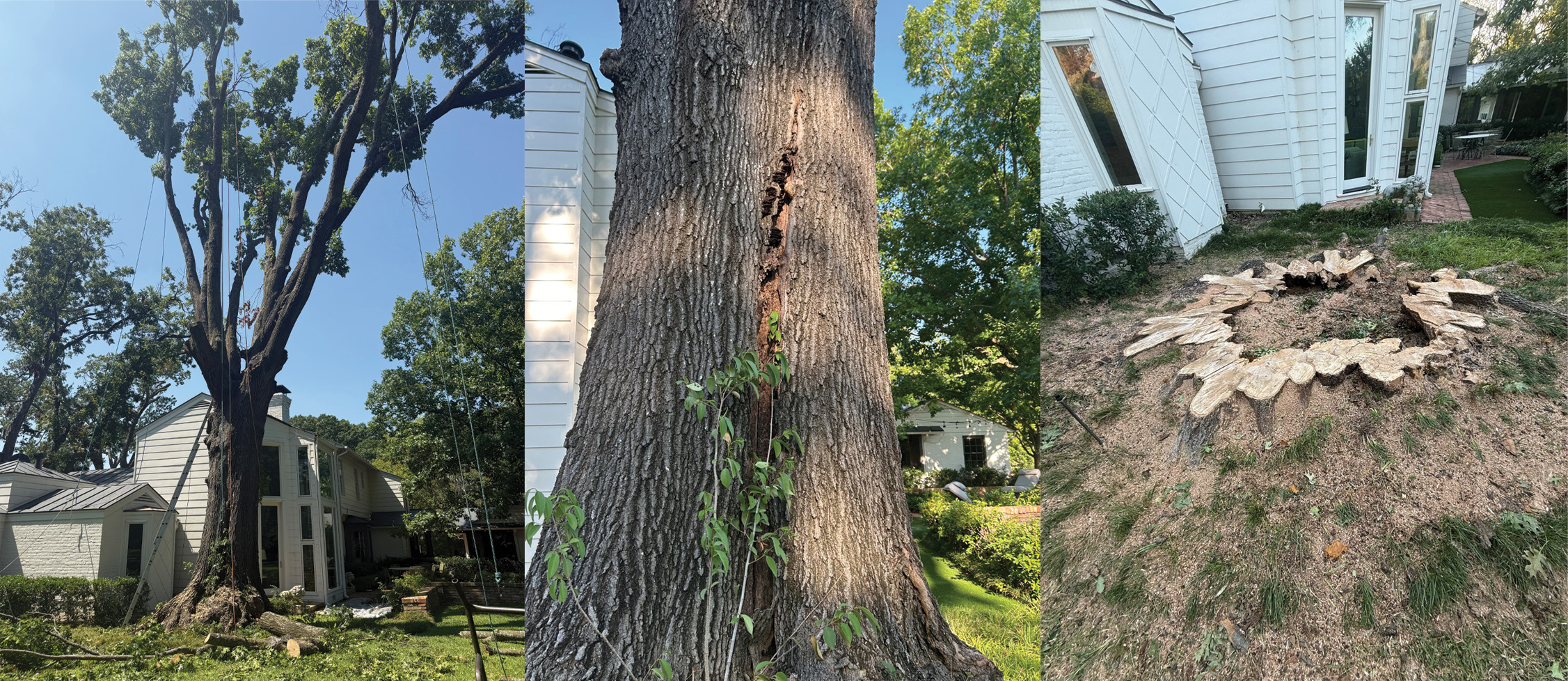How Much Does It Cost to Remove a Tree?

With the extensive freeze damage seen in February 2021, many North Texas trees were not able to recover. As a result, with the arrival of Summer 2021, we began recommending removal for many trees that were on the “wait and see” list. A perennial question, “how much does it cost to remove a tree?” became one we started hearing multiple times a day.
Like with many other tree care services, removal costs can vary greatly, as every tree is different. It is practically impossible to give an accurate removal quote from a photo or description of a tree, as the factors that contribute to removal cost are many. In order to give an accurate price quote for complete tree removal, a visit to the site is always necessary.
What are the Factors Determine Tree Removal Cost?
Tree removals can cost anywhere from $10 to $10,000, depending on a number of specific factors:
-
Tree Species
- Some trees have especially hard wood or are prone to weak joints, affecting the time and precautions taken in removal.
- Trees with thorns are more difficult to remove.
- The type of bark a tree has (smooth or rough, thin or thick) affects the ability to secure climbing, safety, and hoisting ropes and other hardware.
- Palm “trees” (technically more closely related to grasses) are structurally different from other trees and require different removal techniques.
-
Tree Health
- Dead trees are inherently more dangerous to remove than living ones.
- As the wood dies and dries out, it can become unpredictably brittle and breakable.
- The presence of rot, fungus, or other infections can lead to tree weakness and breakage.
- Of particular concern is root rot, usually caused by the fungus Kretzschmaria deusta or members of the genus Ganoderma.
- Instability at the base of a tree can make climbing it impossible, necessitating the use of a crane or bucket truck, which can greatly increase removal price.
- Palms can be more easily affected by rot-related instabilities, leading to bending or drooping and making removal difficult.
- Dead trees are inherently more dangerous to remove than living ones.
-
Location and Drop Zones
- Where a tree is located on a property (proximity to structures/wires, accessibility) determines how long a removal can take.
- The need to move debris a long way greatly increases job duration.
- The immediate area around the base of the tree (the “drop zone”) is critical to a safe removal.
- If a tree is crowded by other plants or close to structures, drop zones can be greatly restricted.
- As with structural instabilities, tree location can dictate whether climbing is possible or whether heavy equipment and other machinery must be used for removal.
- Where a tree is located on a property (proximity to structures/wires, accessibility) determines how long a removal can take.
-
Debris Haul-Off
- If debris from the tree removal is able to be left on-site for municipal removal or other use, removal cost can be significantly less.
- Private tree companies must either recycle wood debris themselves or pay to dump wood waste at a landfill or recycling facility.
- Depending on the particulars of the removed tree, the wood may be useful for firewood or other recycling or may be afflicted with rot or other defects, making it unusable.
While many of these factors, such as location and health issues, may be outside of the immediate control of the tree owner, stability issues always increase over time. Waiting to remove a dead or diseased tree increases not only the risk of injury and property damage, but also the cost to remove it. If you have a tree you think might need to be removed, contact a local ISA Certified Arborist as soon as possible to have the tree evaluated.
The cost of tree removal can range into the tens of thousands of dollars, and is no small expense. Before contracting a company to remove your tree, be sure to ask for an explanation of their removal methods and safety precautions. If you are concerned about property damage or other issues, ask for a certificate of liability insurance to make sure that you will not be held responsible for any unforeseen costs. Finally, be wary of tree removal companies that ask for payment up front. Don’t make a down payment without a written contract and avoid companies who are not bonded or who refuse to disclose their insurance information.
A NOTE ABOUT STUMP GRINDING
Even after the above ground material of a tree is removed, an extensive underground stump and root system can remain. When soliciting bids for complete tree removal, be sure to ask about options for dealing with the stump and roots.
One common method for reducing underground tree material is stump grinding. Stump grinding can level the former site of a tree to allow for sod installation or planting beds. However, even with stump grinding, re-planting another tree in the same location is not recommended. For more info on stump grinding, visit this page.
At Texas Tree Surgeons, we love trees and we love our community! While we do what we can to preserve our urban forest, we know that removal is sometimes necessary. We offer a transparent quote process and written estimates for every job; your arborist is always available to answer any questions you have about tree removal procedures, precautions, and costs. We use highly-skilled and trained climbers who are able to remove just about any tree, large or small, without the use of cranes or other heavy equipment. We quote removal cost and stump grinding separately so that our customers can prioritize what is important to them. Depending on location and time of year, we may be able to offer a discount for debris stacking or alternate haul-off options. Have a tree that might need to come down? Don’t wait! Schedule a visit from one of our ISA Certified Arborists today!
Related Blogs
Similar blogs related to this topic


When are Cranes Necessary for Tree Removal?
It’s really important to get a good look at the tree’s weaknesses before taking it down. Knowing what’s wrong helps keep everyone and everything safe during the removal. Different problems like cracks, holes, sickness, or…
Read more

10 Signs You Need Emergency Tree Removal Services
Trees add beauty and value to any property, but when they’re damaged or diseased, they can become a liability. This is why we recommend annual tree assessments from a certified arborist. Annual arborist inspections allow…
Read more

Why Might Emergency Tree Removal Be Required?
Trees are a beautiful and essential part of our environment, but sometimes they can pose unexpected problems or hazards. In certain situations, emergency tree removal becomes necessary to ensure the safety of people and property.…
Read more
